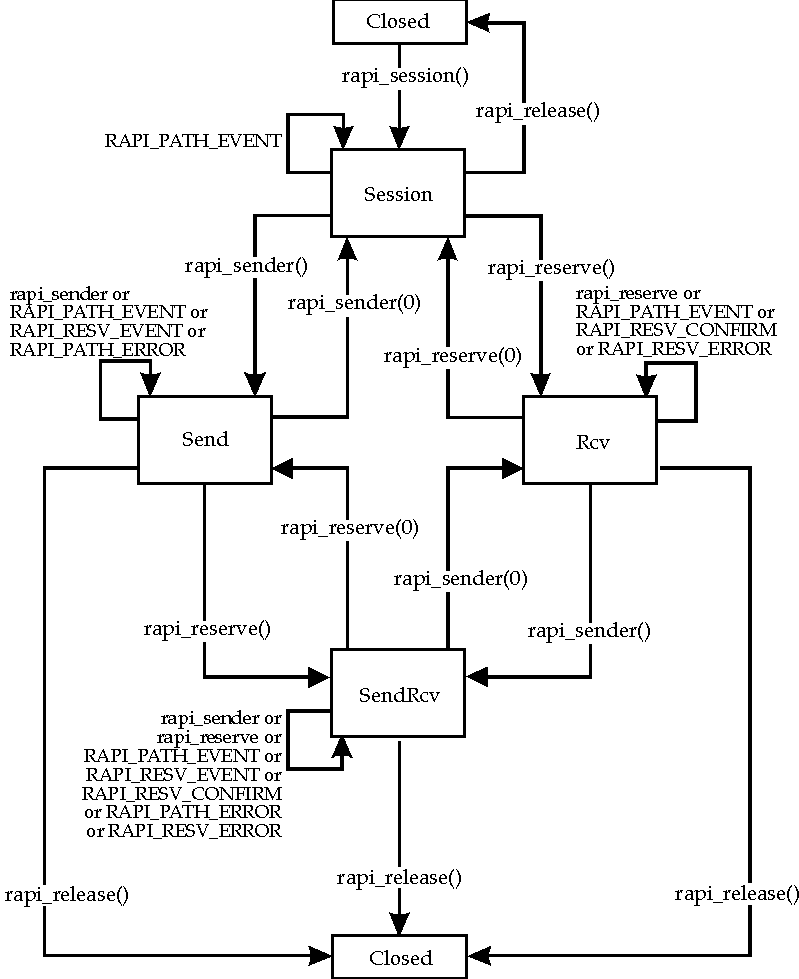Previous section.
Resource ReSerVation Protocol API (RAPI)
Copyright © 1998 The Open Group
Overview
Positioning
An Internet application uses some
API
(Application Programming
Interface) in order to request enhanced quality-of-service (QoS).
The local implementation then uses the RSVP protocol to
propagate the QoS request through the routers along the path(s) for the
data flow. Each router may accept or deny the request, depending
upon its available resources. In the case of failure, the local
implementation will return the decision to the requesting
application via the API.
This specification describes a particular RSVP API known as
RAPI.
Applications use RSVP to obtain consistent QoS for end systems in
packet-switched internetworking.
Reservation Model
RSVP is a receiver-oriented signalling protocol that enables
applications to request quality of service on an IP network.
The types of quality of service applications may
request are defined by Integrated Services.
RSVP signalling applies to simplex unicast or multicast
data flows. Although RSVP distinguishes senders from receivers,
the same application may act in both roles.
RSVP assigns QoS to
specific IP data flows which can be either
multipoint-to-multipoint or point-to-point and are
known as
sessions.
A session is defined by a particular
transport protocol, IP destination address, and destination port.
In order to receive data packets for a particular multicast
session, a host must have joined the corresponding IP multicast
group.
A data source, or
sender,
is defined by an IP source address and
a source port
or, alternatively, by an IPv6 source address and flowlabel.
A given session may have multiple senders S1, S2, ... Sn,
and if the destination is a multicast address, multiple
receivers
R1, R2, ... Rm.
Under RSVP, QoS requests are made by the data receivers. A QoS
request contains a
flowspec,
together with a
filter spec.
The flowspec includes an
Rspec,
which defines the desired QoS and is
used to control the packet scheduling mechanism in the router or
host, and also a
Tspec,
which defines the traffic expected by
the receiver. The filter spec controls packet classification to
determine which senders' data packets receive the corresponding QoS.
The detailed manner in which reservations from different receivers
are shared in the Internet is controlled by a reservation
parameter known as the
reservation style.
The RSVP Functional Specification (see referenced document
RFC 2205)
contains a definition and explanation of the
different reservation styles.
API Outline
Using the RAPI interface, an application uses the
rapi_session()
call to define an
API session
for sending a single simplex data
flow and/or receiving such a data flow. The
rapi_sender()
call may then be used to register as a data sender, and/or the
rapi_reserve()
call may be used to make a QoS reservation as a
data receiver.
The
rapi_sender()
or
rapi_reserve()
calls may be
repeated with different parameters to dynamically modify the state
at any time or they can be issued in null forms that retract the
corresponding registration. The application can call
rapi_release()
to close the session and delete all of its resource
reservations. The relationship among the RAPI calls is
summarized by the RAPI state diagram shown in
RAPI State Diagram
.
The calls
rapi_sender()
and
rapi_reserve()
represent null calls in that diagram.
Note that a single API session, defined by a single
rapi_session()
call, can define only one sender at a time. More than one API
session may be established for the same RSVP session. For
example, suppose an application sends multiple UDP data flows,
distinguished by source port. It will call
rapi_session()
and
rapi_sender()
separately for each of these flows.
The
rapi_session()
call allows the application to specify an
upcall
(or
callback)
routine that will be invoked to signal
RSVP state changes and error events. There are five types of event:
-
RAPI_PATH_EVENT signals the arrival or change of path state.
-
RAPI_RESV_EVENT signals the arrival or change of
reservation state.
-
RAPI_PATH_ERROR signals the corresponding
path
error.
-
RAPI_RESV_ERROR signals the corresponding
reservation
error.
-
RAPI_RESV_CONFIRM signals the arrival of a CONFIRM message.
Each RAPI implementation must provide and document a mechanism to
receive the incoming asynchronous events and call the application
upcall function.
Those systems which provide either the
select()
or
poll()
functions must provide the mechanism described in
Use with select() or poll()
.

Figure: RAPI State Diagram
A synchronous error in a RAPI routine returns an
appropriate error code. Asynchronous RSVP errors are delivered to
the application via the RAPI upcall routine.
Error handling is described in
Error Handling
.

